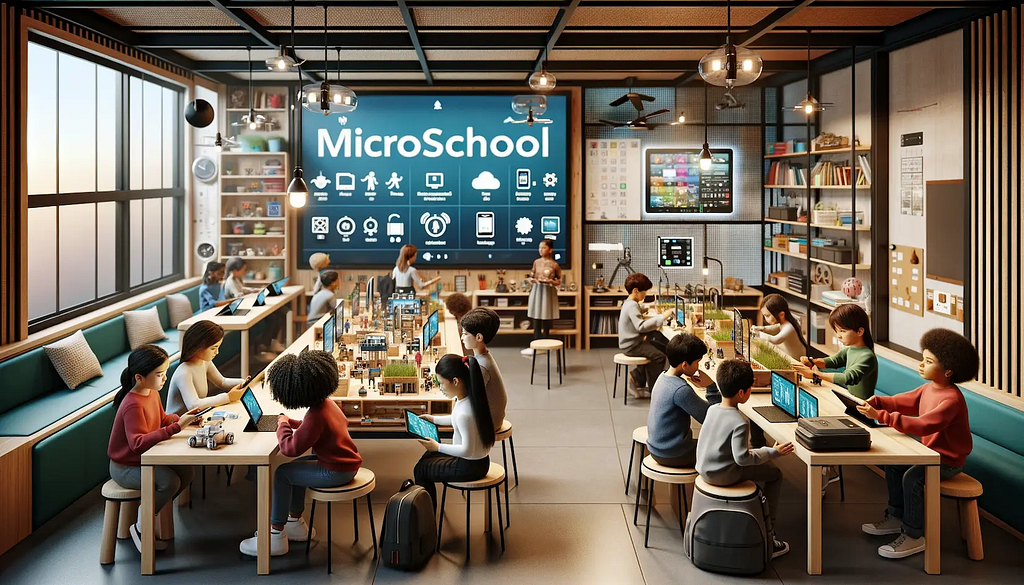
The Rise of Microschools: A New Frontier in K-12 Education
As traditional educational models face scrutiny, particularly after the COVID-19 pandemic, families are increasingly seeking alternatives that cater to their children’s unique needs. Microschools, often characterized by small class sizes and tailored curricula, offer an innovative solution that blends elements of homeschooling with the social benefits of conventional schooling.
The microschool model not only fosters academic growth but also nurtures social-emotional development, creating a supportive community where families play an integral role in their children’s education. As more parents explore these options, the microschool movement is gaining momentum, signaling a new frontier in education that challenges established norms and empowers families to take charge of their children’s learning journeys.
India Has a Large and Growing Population of Individuals Seeking Quality K-12 Education
Source: IMF World Economic Outlook Database October 2019 and World Population Review
India’s demographic dividend presents both immense opportunities and formidable challenges when it comes to education. With a population of over 1.3 billion people and a median age of just 28 years, the demand for quality K-12 schooling is immense and rapidly growing. With over 1.5 million schools and 218 million students enrolled, the Indian K-12 education market is projected to reach $125.8 billion by 2032, growing at a rate of 10.7% annually.
Despite significant improvements in access to education, especially at the primary level, a large portion of the population remains underserved by the traditional schooling model. Many parents, particularly in urban and semi-urban areas, are actively seeking alternatives that can provide a more personalized, engaging, and future-ready learning experience for their children.
The Middle-Class Segment is Booming & Demanding Better Education With Innovative Practices
Source: PRICE
India’s education market is growing fast, fueled considerably by the burgeoning middle class. This demographic shift is significantly influencing the educational landscape, as the middle class increasingly seeks better educational opportunities for their children. With rising incomes and aspirations, families are prioritizing quality education as a means to secure a prosperous future. This has led to a heightened demand for innovative educational practices that go beyond traditional teaching methods, incorporating technology and modern pedagogical approaches.
In Frame: Central Square Foundation, UDISE
Parents are investing in private schooling and supplementary coaching to ensure their children receive an education that meets these higher expectations. This shift not only reflects a desire for academic excellence but also aligns with the aspirations of a generation that is tech-savvy and aware of global trends. Consequently, this surge in demand is driving an increase in the number of premium and international schools across the country, further harmonizing the demand and need for differential learning environments.
Source: ISC Research
Despite Such a Push, India K-12 Continues to Face Many Challenges Leading to Quality Deficiencies
The traditional K-12 education system in India grapples with a multitude of challenges that significantly impact the quality of education and learning outcomes across the country.
At the forefront is the issue of quality disparity, with wide gaps existing between urban and rural schools, as well as between government and private institutions. This inequality leads to vastly different educational experiences and opportunities for students based on their socioeconomic background and geographic location. Compounding this problem are widespread infrastructure deficits. The scarcity of modern learning tools, computers, and internet connectivity further widens the digital divide.
Curriculum and pedagogy in many Indian schools remain outdated, with a persistent focus on rote learning rather than critical thinking and 21st-century skills. The emphasis on memorization over understanding is further reinforced by assessment methods that rely heavily on high-stakes examinations, promoting cramming rather than deep comprehension and application of knowledge.
Additionally, the one-size-fits-all approach prevalent in most schools fails to address the diverse learning needs and paces of individual students, with limited support for those with learning disabilities or special needs. The challenges extend to the teaching profession as well, with high student-teacher ratios, teacher absenteeism, and inadequate professional development opportunities affecting the quality of instruction.
Microschools Have Emerged as a Formidable Solution to Address Some of These Challenges
Microschools are small, personalized learning environments typically serving 15–150 students, often employing mixed-age classrooms, project-based learning, and leveraging technology to deliver a highly customized educational experience. They combine elements of homeschooling, online learning, and traditional schooling, and are gaining traction among parents seeking a more tailored education for their children.
The microschooling movement started with families wanting to reclaim control of their learners’ educational trajectories from the institutions they’ve historically relied upon to meet their educational needs. With their aggressive marketing to adapt quickly to the evolving needs of students and families, microschools offer a fresh approach to education that starkly contrasts with the bureaucratic and stagnant nature of traditional schools.
Microschools solve some of the key challenges that persist in the traditional K-12 education system, with their distinguished features and operations:
Personalized Learning: A significant advantage of microschools is their ability to offer highly personalized education. With smaller class sizes, typically ranging from 10–15 students per teacher, educators can tailor their instruction to each student’s individual needs, learning style, and pace, allowing for more effective learning.Flexible Curriculum and Pedagogy: Unlike traditional schools that often follow rigid, standardized curricula, microschools have the flexibility to adapt their educational content and methods. They can incorporate innovative teaching approaches, integrate current events into lessons, and adjust the curriculum based on students’ interests and needs.Emphasis on Holistic Development: Microschools typically focus on the holistic development of students, including social-emotional learning, character development, and life skills. This comprehensive approach to education can lead to well-rounded individuals who are better prepared for life beyond academics.Cost Effectiveness and Accessibility: Microschools can often operate with less physical infrastructure than traditional schools. This can make them more cost-effective to set up and run, potentially allowing for more resources to be directed towards educational quality.Strong Community and Parent Involvement: The small size of microschools fosters a tight-knit community. Parents often have more opportunities for involvement and communication with teachers. This strong school-family connection leads to better support for students and a more cohesive educational experience.
The microschooling sector typically has 3 different types of players:
Independent Microschools: These are small groups forming in art and dance studios, empty storefront spaces and other creative locations, or private homes. These microschools are often the most unique and creative and flourish in the communities they serve.Partnership Microschools: They forge a collaboration between a host partner, like an employer, local government agency, or place of worship, that can bring resources or facility space, and a technical partner that brings the expertise to be responsible for teaching and learning.Provider Networks: They act as key support vehicles in the microschooling ecosystem and include established organizations, such as KaiPod, Acton, or Primer to name a few, that can help support launches by bringing capital, back-office help, often with innovative education technology, and other institutional help new founders find valuable.AltSchool operates a technology-enabled network of microschools focused on personalized learning and whole-child development, utilizing a proprietary software platform to enhance educational experiences across its small, community-oriented schools.Acton Academy emphasizes student-driven learning through a blend of online and project-based education, encouraging students to take ownership of their education while fostering critical thinking and collaboration in multi-age classrooms.Founded by Sal Khan, the Khan Lab School integrates blended learning with a focus on personalized education, allowing students to progress at their own pace while engaging in real-world projects that reflect the principles of Khan Academy.Primer is a rapidly growing microschool network that promotes diverse academic experiences for students and leverages a cutting-edge tech platform called Prism to track student learning and utilize AI to group students across campuses by specific skills.Schoolhouse is a network of microschools that focuses on small group learning experiences led by trained facilitators, enabling students to engage deeply with subjects through collaborative projects and personalized instruction in a supportive environment.Prenda supports independent microschool leaders by providing resources and community connections, enabling families to create intimate learning environments that cater to their children’s specific educational needs.
While Microschools are Still Nascent in India, Their Mushrooming Growth Shows Solid Traction
Source: Indian School Education System (ISES)
In recent years, India has witnessed a quiet revolution in its educational landscape with the emergence of microschools and alternative learning models. These innovative educational approaches challenge traditional schooling by offering personalized, flexible, and engaging learning experiences.
This growth is fueled by a combination of factors, including increasing dissatisfaction with traditional schools, rising awareness of Indian parents regarding alternative education methods, and the growing acceptance of technology and personalization in classrooms.
While there are multiple standalone microschools and small chains that have come up, the space is still hot with opportunities for larger organized chains to evolve and capture market share as the industry matures.
Dreamtime Learning School is a unique educational institution that embraces alternative teaching methods and focuses on holistic learning, incorporating storytelling, nature-based activities, and creative arts into its curriculum.Comini Microschool holds the distinction of being Mumbai’s first microschool, offering an alternative, progressive education for children aged 2 and up, focusing on a finnish-inspired approach with emphasis on play-based learning and personalized learning paths.
Located in Velachery, Chennai, Geekz Microschool has seen remarkable growth, with a 300% increase in admissions and inquiries over six months. Key aspects of Geekz Microschool include activity based learning, diverse subject offerings, and innovative schedules.Aurinko Academy is a microschool that emphasizes personalized education tailored to the individual needs of students. This academy focuses on fostering a love for learning through a curriculum that integrates academic rigor with social-emotional development.The Shishya Jigyasa Academy is a microschool that emphasizes inquiry-based learning and holistic education for students. It aims to cultivate curiosity and critical thinking through engaging, hands-on experiences.The Kaleidoscope Learning Centre (KLC) is a special school dedicated to serving the needs of the growing number of children with developmental disabilities. The school strives to develop in each student, a self-esteem and respect for others and an appreciation for his/her own unique gifts and talents.
Vast Opportunity Lies for Forward-Looking Operators to Scale Thematic Microshooling Models
The emerging microschooling landscape in India presents a significant opportunity for innovative education operators and investors to capitalize on the growing demand for personalized, theme-based learning experiences.
By establishing scalable chains of thematic microschools, operators can tap into diverse market segments and address the varied educational preferences of India’s burgeoning middle class. These thematic chains could range from STEM-focused curricula and arts-intensive programs to multilingual immersion schools or entrepreneurship-centric models, as well as sports-focused schools.
Operators should consider this approach for several compelling reasons:
Differentiation: In a crowded education market, thematic microschool chains can stand out by offering unique value propositions tailored to specific interests and career aspirations.Economies of scale: While maintaining the intimate learning environments characteristic of microschools, operators can leverage centralized resources, curriculum development, and administrative functions across multiple locations.Adaptability: Thematic models allow for quicker adaptation to emerging trends and skills demands in the job market, ensuring relevance and attractiveness to parents and students alike.Targeted marketing: Focused themes enable more precise marketing strategies, potentially reducing customer acquisition costs and increasing enrollment rates.Investment appeal: For investors, thematic chains offer a scalable business model with the potential for rapid expansion and clear brand identity, which can be particularly attractive in the education sector.
By focusing on thematic microschooling chains, operators and investors can position themselves at the forefront of India’s educational evolution, meeting the growing demand for specialized, high-quality learning experiences while building scalable and potentially lucrative educational enterprises.
Microschooling Market in India is Poised for Transformative Growth Driven by Various Factors
The microschooling movement in India is facing significant tailwinds, driven by a confluence of factors that are transforming the education landscape. As parents and educators seek alternatives to the traditional school system, microschools are emerging as innovative and effective models that prioritize personalized learning, flexible schedules, and engaging teaching methods.
The rise of microschooling in India is not only a response to the shortcomings of the current system but also a proactive step towards creating a more adaptive and student-centric approach to education. A confluence of factors has been fueling the growth of microschools in India:
Growing Demand for Personalized Education: India’s traditional education system has been criticized for its one-size-fits-all approach. Microschools offer a more tailored and individualized approach to learning, catering to the unique needs and interests of each student.Adoption of Technology-Enabled Learning: Microschools are likely to increasingly incorporate technology-enabled learning, blending online and offline experiences. The integration of technology can enhance the learning process and help in addressing India’s widespread accessibility gap in education.Teacher Entrepreneurship: Indian teachers have increasingly expressed interest in starting their educational ventures in recent times. Microschools offer a viable path for educators to become entrepreneurs, with low capex requirements, and freedom in pedagogical approaches.Expansion into Underserved Areas: The microschool movement is expected to expand into tier-2 and tier-3 cities in India, bringing innovative education models to areas that have traditionally been underserved. This expansion will increase access to personalized and engaging learning experiences for a larger segment of the population.Demand for Multilingual Education: India’s linguistic diversity creates demand for schools catering to specific language needs. The Annual Status of Education Report (ASER) 2023 found that 68% of rural parents preferred multilingual education for their children. Microschools can more easily adapt to offer instruction in multiple languages.Focus on 21st-Century Skills: A 2023 FICCI-EY report on the future of jobs in India highlighted a significant skills gap, with only 45% of graduates considered employable. Microschools, with their ability to quickly adapt curricula, are well-positioned to focus on in-demand skills like critical thinking, creativity, and digital literacy.
The rise of microschools signifies a pivotal moment in K-12 education, offering families an alternative that prioritizes personalization and flexibility. As this movement continues to evolve, it has the potential to reshape the educational landscape by empowering parents and students alike. By embracing innovative teaching methods and fostering strong community connections, microschools are paving the way for a new educational frontier — one that values individual learning journeys over standardized approaches.
LoEstro Advisors is an investment banking firm specializing in sell-side fundraise and M&A advisory, along with a strong consulting arm. Recognized as the #1 financial advisor in education in India, we are the advisor of choice to India’s blue-chip education businesses.
Over the last four years, we have grown to be one of India’s largest (in terms of M&A transactions) homegrown boutique investment banks, with $1.2bn+ worth of combined deals closed across education, healthcare, consumer, and technology sectors.

